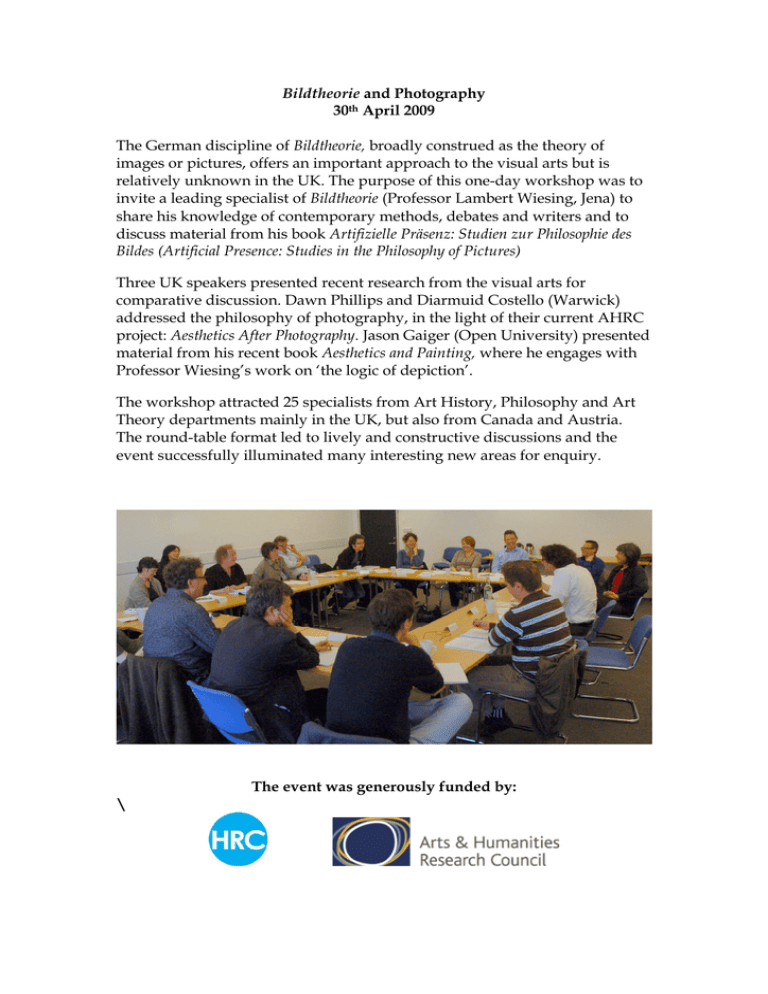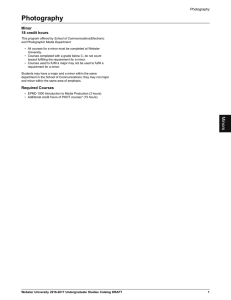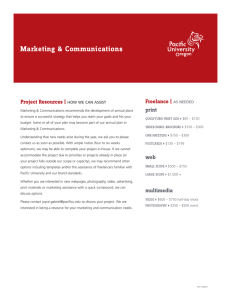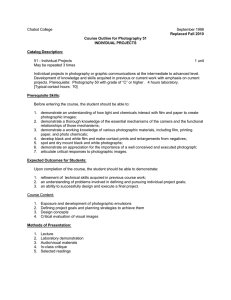Bildtheorie 30 April 2009 Bildtheorie,
advertisement

Bildtheorie and Photography 30th April 2009 The German discipline of Bildtheorie, broadly construed as the theory of images or pictures, offers an important approach to the visual arts but is relatively unknown in the UK. The purpose of this one-day workshop was to invite a leading specialist of Bildtheorie (Professor Lambert Wiesing, Jena) to share his knowledge of contemporary methods, debates and writers and to discuss material from his book Artifizielle Präsenz: Studien zur Philosophie des Bildes (Artificial Presence: Studies in the Philosophy of Pictures) Three UK speakers presented recent research from the visual arts for comparative discussion. Dawn Phillips and Diarmuid Costello (Warwick) addressed the philosophy of photography, in the light of their current AHRC project: Aesthetics After Photography. Jason Gaiger (Open University) presented material from his recent book Aesthetics and Painting, where he engages with Professor Wiesing’s work on ‘the logic of depiction’. The workshop attracted 25 specialists from Art History, Philosophy and Art Theory departments mainly in the UK, but also from Canada and Austria. The round-table format led to lively and constructive discussions and the event successfully illuminated many interesting new areas for enquiry. The event was generously funded by: \ Speakers: Lambert Wiesing is President of the German Society for Aesthetics and Professur für Bildtheorie und Phänomenologie at the University of Jena. Diarmuid Costello is Chair of the British Society for Aesthetics and Codirector of the AHRC Project Aesthetics After Photography. Dawn Phillips is the Philosophy Research Fellow for the AHRC Project Aesthetics After Photography. Jason Gaiger studied Art History and Philosophy in St Andrews, Essex and Heidelberg and lectures in Art History at the Open University. Titles and Abstracts Lambert Wiesing - When Images are Signs: The Image Object as Signifier The phenomenological approach in image theory defends the view that an image can be a sign, but does not have to be. Hence for every photograph it remains a possibility that it does not have a reference, although it is the product of a causal process. Today, this classic phenomenological view, which can be found both in Husserl and Sartre, requires us to describe the process of using images as signs. I would like to present the following theses in the workshop: If an image is used as a sign, it is the image object – and not the image carrier – which functions as sign carrier. Although a photograph need not be a sign, there is a typical way of using photographs as signs. If a photograph functions as a sign, the causal photographic process is considered as a criterion to determine the possible reference of the photograph. Jason Gaiger - Leaving the empirical behind: On Wiesing's concept of a 'universal science of image’' Lambert Wiesing identifies the ‘philosophical interest in the concept of an image’ with the ‘tendency towards a universal science of images [allgemeine Bildwissenschaft]’. This requires not merely a quantitative extension of the type of empirical research carried out in art history and other related disciplines but a ‘change of method’, a ‘shift towards the categorical’ [Artifizielle Präsenz, p. 13]. In this paper, I investigate the problematic distinction between empirical and categorical enquiry by examining Wiesing’s earlier attempt to develop a ‘logic of the image’ through a formal-logical reconstruction of Heinrich Wölfflin’s fundamental concepts of art history. I argue that the reconstruction of the fundamental concepts as strictly relational categories solves a number of problems inherent in stylistic analysis, but that it does so at the price of no longer being able to account for historical change. Diarmuid Costello - The Question Concerning Photography The paper aims to bring out the missed encounter between the analytic philosophy of photography post-Walton and Heidegger’s writings on art, modernity and technology. I argue that Heidegger’s anti-subjectivist philosophy of art as poeisis, broadly construed (techne as a handmaiden to phusis), can be read as an argument, avant la lettre, for photography as understood in the analytic philosophy of photography since Walton (i.e., in terms of photography’s mind independent counterfactual dependency on how things stand in the world). If this is correct, photography—contra Heidegger—provides the best prospect of a ‘decisive confrontation’ with technology that Heidegger sought from genuine art. This should be news to Heideggerians and analytic philosophers of art alike. More speculatively, I shall suggest that both accounts are contentious, precisely in so far as they do agree: Heidegger’s appeal to particular artists is in tension with his antisubjectivism in the philosophy of art, and analytic philosophers swayed by the mind-independence thesis underplay the intentionality of photography as art, and hence the photographer’s presence in their work. Dawn Phillips - Visual Composing: Comparing photographs with works of music I draw a comparison between photographs and works of music to address two central concerns in the philosophy of photography: intentionality and depiction. I use a comparison between musical composition and photographic visualisation to show how intentionality relevantly features throughout the photographic process when creating a work of art. I use a comparison between musical performances and photographic prints to dislodge the idea that depiction is the only way to understand the aesthetic qualities of a photographic artwork. For full details of the workshop: http://www2.warwick.ac.uk/fac/soc/philosophy/research/activities/ aestheticsafterphotography/bildtheorie2009workshop/







